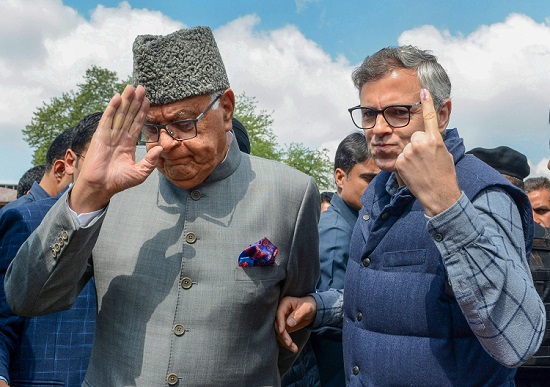
As the new government starts taking on the responsibility of governing the nation, Kashmir will once again take centre stage. Pakistan has already started laying the foundation for resumption of talks, towards which end, Prime Minister Imran Khan has made many overtures. The election results will give six members of Parliament from the state. It is hoped that this lot will represent the state at the centre in the true sense.
The most important factor, however, will remain dealing with the internal situation in the state, especially so the Kashmir Valley. No serious incident of violence was reported during the course of the elections. Candidates have been able to campaign fearlessly and polling has been peaceful. It is quite apparent that the security forces have, yet again, created an environment of peace wherein political activity is possible; it is now up to the political leadership to leverage the same and apply a balm on the open wounds of the people who have been traumatised by violence and disruption for decades on end.
Assembly elections will be the next big political activity in the state. They will be conducted under the watchful and experienced eye of Governor Satya Pal Malik. The Governor has been in the state long enough to understand all the nuances; he has conducted himself with grace and maturity in many critical situations. It can be said with reasonable confidence that the elections will be conducted in a free and fair environment under this watch.
The entire nation was quite fed up with the constant negativity of the campaigns during the Lok Sabha polls; people heaved a sigh of relief when the results were declared on May 23rd. Imagine the plight of the people of Jammu and Kashmir who are going to be subjected to yet another round of this negativity during the State Assembly elections. The need of the hour is moderation in tone and tenor of the election campaign. The political parties, more so the local variety, should not follow the tried and tested path of running harmful campaigns based on blame games and painting of dismal scenarios. It is a wish that may not see the light of day since political parties are without new leadership or new ideas but should it happen it would do a world of good to the region.
The people in Kashmir, having neutralised the cult of violence and foreign sponsored terrorism most bravely, hand in hand with the security forces, are now looking for a normal life wherein they can function unhindered. They want a peaceful environment that allows them to look after their families and tread along the path of overall development along with the nation.
The most important dimension in this tryst for peace is the youth of the region. Their problems, aspirations and insecurities need to be addressed in priority. Even, Governor Satya Pal Malik has repeatedly stressed on the point of engaging the youth of the state, especially in Kashmir Valley, in a positive manner. He consistently emphasises the point that terrorism would not end with the elimination of terrorists but by engaging them in a positive manner and to do so, weaning away the youth from the self-destructive path of terrorism is essential. The number of youth pursuing the path is small when seen as a percentage of the young population of the Valley, but, the objective should be that not even one boy becomes a terrorist.
Checking radicalisation of the youth is imperative for the valley and the biggest role in this direction is to be played by the civil society. It is the parents, elders, religious leaders, teachers, intellectuals, role models and most of all the political leaders who can motivate the youth to engage in gainful activity and look for an aspiring life, rather than meeting an ignominious death as a terrorist for no reason whatsoever. The political leaders are the most important link in this chain of civil society engagement since they can not only motivate but also put in place the necessary policies and infrastructure to ensure that the youth remains protected from bad influence and focussed on to building their careers and lives.
The political leadership of the valley would be well advised to take a leaf out of the “Winning Hearts and Minds’ (WHAM) initiative of the Indian Army that has been in place since many decades now. It provides succour through the welfare initiative, Operation Sadbhavana, in a manner that gains the confidence of the common man. It needs to be studied closely by the political leadership to understand exactly what the common man aspires for and how it can be provided.
The political parties need to focus attention to the real issues being faced by the people of the state; if they speak a voice that integrates rather that divides; if they attempt to build bridges with the central government and the rest of the nation instead of increasing the insecurity of the people, the scenario in the region will change drastically. In the coming elections, the manifesto of the political parties should include all such issues that are causing agitation and the means to dispel the same.
In case the political parties fail to play up in a manner that ensures advent of peace and prosperity in the state then the hard work of the security forces in creating an environment conducive for political activity is likely to be frittered away, yet again. If the political policies do not witness a paradigm shift, there are chances of the people emerging more grieved and emotionally shattered by the time the results of the assembly elections are declared.
It is sincerely hoped that the political leadership will respond and the situation in the valley would take a turn for the better. This is the time for the last push!
